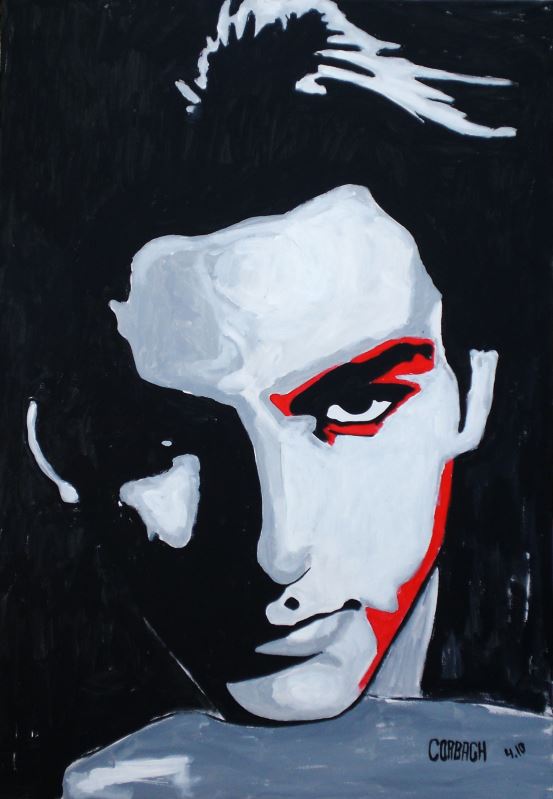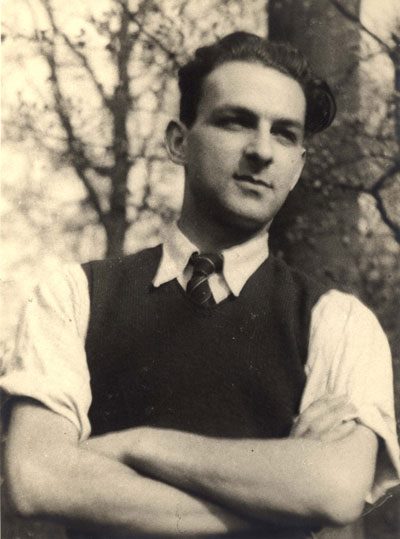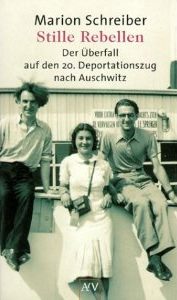


Youra Livchitz
, ermordet am 2. Juni 1943
Acryl auf Leinwand
70 x 100 cm
entstanden 04.2010
Ihre Widerstandsaktion war mehr als spektakulär: Ausgestattet mit gerade mal drei Kneifzangen, einer roten Sturmleuchte und einem Revolver überfallen drei junge Belgier 1943 einen Deportationszug, der von Mechelen nach Auschwitz unterwegs ist.
Willy Berler, ein Überlebender
von Auschwitz, über die ungewöhnliche Tat im besetzten Belgien:
"Ich glaube, dass der Überfall auf den 20. Transport eine der größten
Widerstandsaktionen überhaupt war."
Drei Leute mit einer Laterne und einem Revolver, die einen gut bewachten
deutschen Transportzug aufhalten wollen, dazu gehört mehr als Mut,
dazu gehört Tollkühnheit.
Der Zug, den Youra Livchitz mit zwei Kameraden des belgischen
Widerstandes auf offener Strecke bei Brüssel stoppte, war mit mehr
als 1630 Juden an Bord nach Auschwitz unterwegs. Die Soldaten im ersten
und letzten Waggon waren von der waghalsigen Befreiungsaktion völlig
überrascht. "Wir hatten ein irres Glück", erinnert sich Maistriau,
einziges noch lebendes Mitglied des kleinen Kommandos vom 19. April 1943.
"Heldentat wider alle Vernunft"
An den Jahrestag dieser einzigartigen Aktion, der auch den Beginn des
Aufstandes im Warschauer Getto markiert, wird jedes Jahr in dem kleinen
Ort Boortmeerbeek bei Brüssel in der Woche nach Ostern erinnert.
Gedacht wird einer "Heldentat wider alle Vernunft", wie die Autorin Marion
Schreiber "dieses lebensgefährliche Abenteuer" der drei jungen Männer
in ihrem Buch "Stille Rebellen" einordnet.
Belgiens kommunistische Résistance hatte bereits erwogen, einen
Deportationszug der Nazis zu stoppen und die Insassen zu befreien, wie
Maistriau später erfuhr. Doch dann habe die Gruppe diesen Plan als
zu gefährlich fallen lassen. Youra Livchitz, Robert Mastriau und
Jean Franklemon jedoch radelten am Abend des 19. April 1943 vor die Tore
Brüssels, stellten eine rote Laterne auf die Gleise und lauerten
auf den Transport aus dem belgischen Konzentrationslager Breendonk.
Der Zug kam. Er hielt. Und Livchitz öffnet den Waggon, der vor ihm zum Stehen gekommen war. Fast 60 Menschen waren in den Güterwagen gepfercht. Zwei Frauen sprangen als erste heraus, eine Handvoll Männer folgte. "Aber ein Mann wollte die Leute davon abhalten herauszuspringen", erzählt der Befreier. 17 Menschen verließen den Waggon schließlich und brachten sich im nahen Wald in Sicherheit. Aus dem Waggon nebenan hörte Maistriau Stimmen: "Öffen Sie! Öffnen Sie!" Doch da rollte der Zug schon wieder an.
"Insgesamt flüchteten 231 Deportierte an diesem 19. April 1943 vor der deutschen Grenze aus dem Konvoi", recherchierte Schreiber. "23 Juden starben bei dem Fluchtversuch unter dem Kugelhagel des Begleitschutzes oder durch einen unglücklichen Sturz." Doch alle Entkommenen hätten auf die Hilfe der belgischen Bevölkerung rechnen können - so wie Paul Spiegel, heute Vorsitzender des Zentralrates der Juden in Deutschland.
"Wer ein Menschenleben rettet, der rettet ein ganzes Volk"
Als Zweijähriger war Spiegel mit seinen Eltern auf der Flucht vor den Nazis nach Belgien gekommen. Seine Schwester Rosa wurde zusammen mit 130 anderen Kindern im 14. Deportationszug aus Belgien nach Auschwitz gebracht, Paul überlebte bei freundlichen Bauern in Chapelle-lez-Herlaimont. Die Bedeutung des Überfalls auf den 20. Deportationszug unterstreicht Spiegel mit einem Spruch aus dem Talmud: "Wer ein Menschenleben rettet, der rettet ein ganzes Volk."
Quelle: http://www.stern.de/politik/geschichte/widerstand-der-tollkuehne-ueberfall-auf-einen-todeszug-535522.html
_________________________________________________________________________
The heroes of Mechelen
Equipped with only a lamp, pliers and a pistol,
these three young men rescued hundreds of Jews from a train heading for
Auschwitz and almost certain death. Robert Maistriau, the last survivor
of the... The whole thing took perhaps half an hour 60 years ago. But
Robert Maistriau has never forgotten that moonlit night on a Belgian railway
line in April 1943 as he scrambled to open the doors of a cattle truck
and urged the terrified Jews inside to get out and run away. Shots rang
out from the German guards, but in the confusion 17 prisoners escaped.
Later, further down the track, 200 more managed to flee. The unlucky 1,400
left on the train reached their destination: Auschwitz. Few lived to tell
the tale.
Maistriau, now 82, is the last survivor of an extraordinary act of wartime
resistance to the Nazis. The train he stopped, with two friends, was the
20th convoy transporting Jews from Belgium to the infamous extermination
camp in Poland, where more than a million were gassed. It was a rare red
light for genocide.
Equipped with pliers, a hurricane lamp and a single pistol, the three
executed a plan that had been rejected by organised partisan groups as
too dangerous. Their improvisation and derring-do owed much to the scout
troops where young Belgians, in those pre-TV days, spent much of their
spare time. The intrepid trio even made their getaway by bike. But it
was no Tin Tin adventure: resistance activity or possession of a gun was
routinely punished by death, often after torture.
Maistriau, who today has failing eyesight and a bad leg but a still-sparkling
sense of humour, recalls that their key item of equipment was some red
tissue paper he filched from his mother's drawer at home. That covered
the hurricane lamp and brought the train to a screeching emergency halt
on a bend in the track east of Brussels. "I can still remember the noise
of the brakes," he says.
The attack on the convoy - by coincidence the same day the doomed Warsaw
ghetto uprising began - is widely known in Belgium. But it took a German
writer, Marion Schreiber, to weave the episode into the wider context
of the war, the German military administration, the SS and Hitler's "final
solution" in her fascinating book, Silent Rebels.
Maistriau's baptism of fire could have been any kind of sabotage operation.
But three days beforehand his schoolfriend and croquet partner, Youra
Livchitz, a Russian-born Jewish doctor, told him of the plan. "He said
there would be a train taking Jews to Poland. It's difficult to say now
exactly what we knew then. We knew they were badly treated, but we didn't
know exactly what was going to happen to them. Livchitz didn't know either."
It takes a leap of the imagination to connect the Brussels of today with
the Nazi-occupied capital of the 1940s. In 2003, Avenue Louise, half Park
Lane, half Knightsbridge, is home to sleek EU lobbying firms and multinational
corporations. In 1943 it was the site of Gestapo headquarters, strafed
with stunning precision that January by a Belgian pilot serving in the
RAF. Django Reinhardt was all the rage and the black market was booming.
Starting in 1942 Belgium's Jews were rounded up and taken to a barracks
at Mechelen, dubbed "the ante-chamber of death". From there, meticulously
numbered for the SS files - and the historical record - they went straight
to Auschwitz. Thousands of others, including children, fled or went into
hiding, sheltered by brave non-Jews at enormous risk. Those who dared
go out without wearing the obligatory yellow star were frequently spotted
by a Polish Jewish informer working for the Gestapo.
Belgium has its wartime skeletons, including Flemish and Walloon volunteers
who fought with the Nazis. But the statistics of mass murder tell the
story: 50% of its 56,000 registered Jews survived the occupation. Next
door in the Netherlands, where Anne Frank came to symbolise the human
face of the holocaust, the figure was just 12%.
People reacted differently to the strain of life under occupation. "Often
there is only a very thin line between commitment to collaborationism,
to resistance or to Gaullism," the historian Richard Cobb has written
of France. "One should not exclude the elements of luck and chance, especially
in the lottery of wartime that puts a special premium on unpredictability
that may hand out, with equally blind impartiality, the winning number
or the tarot card of death."
Maistriau's fate was written in his family. His father was liberal and
anti-clerical. His mother's first husband was a French Jew, killed in
the Great War. And there were Jewish friends - Livchitz and others - in
the scouts and at school. He was bored with his desk job in a metals company,
impulsive, and prepared to fight the Germans, still hated for their atrocities
in 1914. "I wasn't crazy, but I was very easily carried away," he explains.
"And I was ready to take risks."
Livchitz, slightly older, was a charismatic figure still remembered vividly
by contemporaries. He was caught months after the attack and executed
as a "communist terrorist", refusing to wear a blindfold as he faced the
firing squad. The third member of the group was Jean Franklemon, an art
student and communist, who was sent to a concentration camp but lived.
Bureaucratic efficiency helped reconstruct this terrible story. Train
801 had 30 trucks carrying 1,631 Jews. The oldest deportee, Jacob Blom,
number 584, was 90. The youngest, Suzanne Kaminski, number 215, was five
weeks. A few, alerted to the escape plan by the resistance, had managed
to saw though bars and doors and were ready when the train stopped. Most
of the others were too frightened or weak.
Maistriau describes how he cut the wire securing the door of one truck,
shouting "Sortez, sortez," and the wry humour of what followed. "What
do you expect us to do now," one anxious woman asked him, looking round
in dismay at the dark and trees. "I said: 'Madame. Brussels is that way,
Louvain is that way. Sort it out for yourselves. I've done all I can.'
But they all made their way safely back to Brussels."
Emboldened by the raid, other Jews escaped when the train resumed its
journey, though some were injured or killed by the fall or the guards'
bullets. Simon Gronowski, 11 at the time, still remembers the last words
his mother spoke to him in Yiddish as he jumped off: "The train's going
too fast." He never saw her again.
Maistriau continued working with the resistance but was captured in 1944,
deported to Buchenwald concentration camp and finally liberated by the
Americans. He spent the rest of his working life farming in Congo, staying
on after independence.
Years later he was recognised as a "righteous gentile" by Israel's Yad
Vashem holocaust centre for helping persecuted Jews. And there were meetings
with survivors or their children at ceremonies commemorating the heroism
of that long-ago night. "At one of them," he says, sounding bemused, "a
woman came up to me and kissed me, and said: 'You saved my life.'"
· Silent Rebels: The true story of the raid on the 20th train to
Auschwitz by Marion Schreiber, is published by Atlantic Books on June
24
http://www.buzzle.com/editorials/6-19-2003-41883.asp